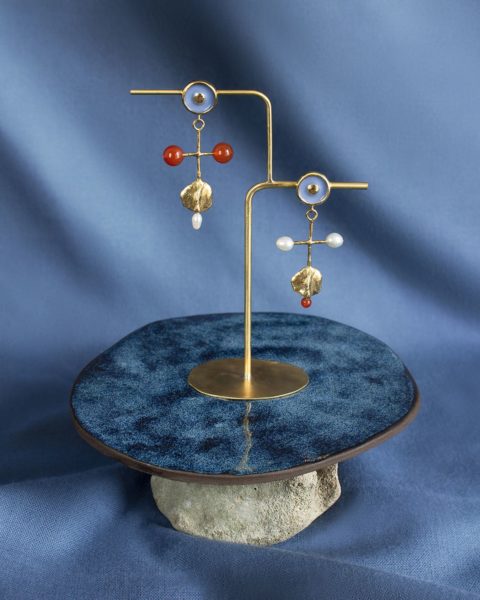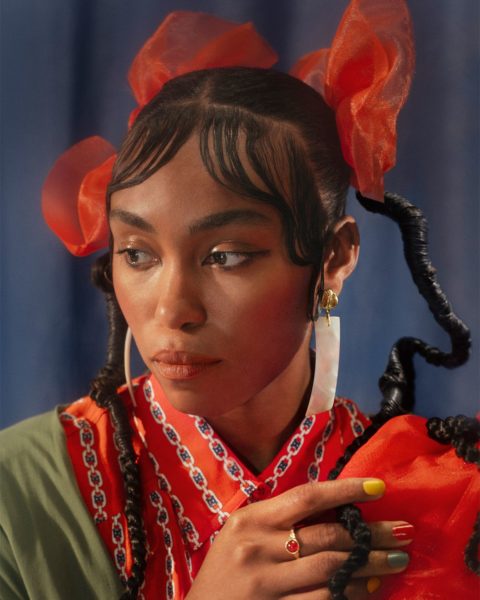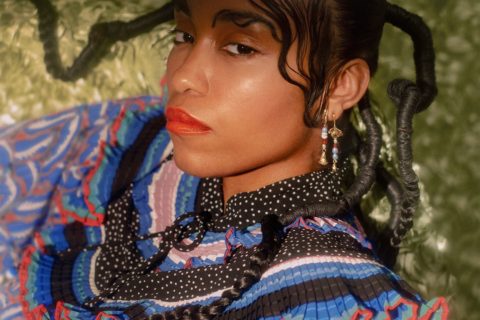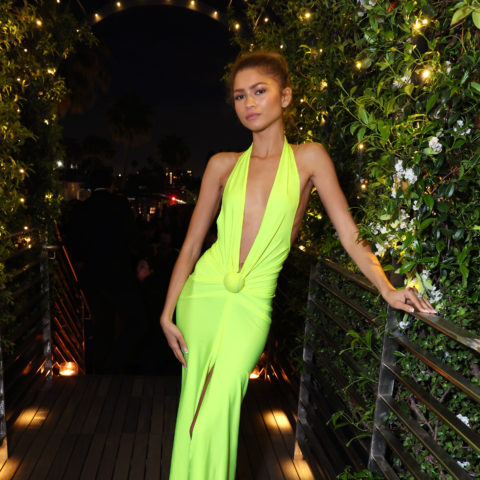Six Questions With Caroline Pham of Montreal Jewellery Brand Ora-C
"We should inspire each other to reach better living standards together, instead of elbowing each other to be at the top of others."
Montreal-based multi-hyphenate Caroline Pham, who launched her accessories brand Ora-C five years ago, looks at the world a little differently. Actually, it’s hard to say if sometimes she’s not looking at this world at all. Instead, Pham–who graduated from Parsons the New School of Design after studying illustration and industrial design–is a vibe seeker. Imagery from cultures both familiar and unfamiliar are the undercurrents of her inspiration, manifesting in evocative handmade pieces like earrings crafted with an assortment of gemstones, and bracelets with ‘piercings’. Having recently re-opened her studio boutique along with L.L.Y Atelier, Pham caught up with FASHION to talk about her magnetizing work and what’s been on her mind during the COVID-19 crisis and uprising of the Black Lives Matter movement.
Tell me about the latest collection, Folk L’Ore. What’s the story behind it, and what’s your favourite piece?
I’ve always used a lot of flowers and rocks in my previous collections’ shoots as props. Nature has been a huge inspiration since day one; the grimmer the world around us gets, the closer I want to feel to nature. But in the Folk L’Ore collection, I used the floral inspiration and the use of stones more literally in the shapes of my pieces. I have botanical references all over, like petal shapes stamped with my finger tips, vine-like swirls or coils, and natural semi-precious gemstones such as carnelian, jade, blue-lace agates and freshwater pearls. This collection is also a slow re-birth of my work toward leaving textiles and tassels behind and embracing the use of stones, which are the main medium I now use in my one-of-a-kind series.
My aesthetic has always looked towards a romantic form of nostalgia for historical jewels, all while making them look like they still belong in modern days. My jewellery lives in a sort of made-up exoticism, like coming from a far away world we think we can recognize, yet cannot quite put our finger on. It’s a theme I have played with a lot in my work due to the fact that I grew up in multiple cultures at once. I never lived each culture in-depth, I therefore would create my own narratives about them since a young age. In my jewellery, I think it allows people to weave their own narrative into the pieces they buy from me. This is the reason why I think jewellery can be so personal and precious to all.
My favourite piece from Folk L’Ore seems to be changing regularly. I personally wear the Ginette earrings everyday! They are these feminine petal-shaped dangles that can look like you have two earrings at once. A nice little tingling sound follows you around all day when you where them. However pieces like the Roberte and the Louisette earrings really make me feel proud of my work. They are the bolder version of my aim to make regal-looking pieces, a fantasy I have been inspired to explore a lot lately.
And tell me about your OOAK designs. What inspires them?
The original inspiration came during my first trip to Mexico three years ago. I traveled with two friends around the country and found so many amazing hand-cut stones and dead-stock loads in bazaars and small towns; the kind you cannot find when buying from regular avenues. I bought so many, it created this new departure for me to attempt to use unique stones in my work for the first time. Before I knew it, it became an annual ritual. To release the new OOAK series in the spring and summer, based on the stones I have been gathering on trips I would take during the winter days.
It’s such a freeing mindset, to break away from the regular fashion schedule and create pieces that are unique and not reproducible. This makes the designing process a lot less restricting and releases my creative juices to go the extra mile with wilder, bolder pieces that can attract a more niche clientele. In fact, this direction is more and more an avenue I have the intention to explore. It is finding parallels to my values as a small business of promoting slow fashion and ethical sourcing. It also refocuses my love for making and designing jewellery in a creative way. To me, mass-producing pieces that are already available on the market for the sake of trend and profit bores me. I guess I am a romantic artist at heart.

How does living in Montreal influence your work?
Montreal is a very progressive city when it comes to sustainability mixed with full-blown creativity. There is a real sense of community that pushes for slower consumerism, environmentally-friendly practices, and support for smaller businesses. In fact, in the last few years I have noticed an ever increasing growth of very interesting brands that is redefining the Montreal fashion scene into one to watch out for in the international sphere.
I feel like moving to Montreal has allowed me to make ORA-C a reality. It’s extremely affordable and is hence a vibrant hub for small businesses and creative people in general. There are so many inspiring people here. The pace of living is really soothing, too. So much stress comes from running a small business alone, if I was still in New York City–I lived there for 10 years before moving back here in 2013–I would have had multiple burnouts already. Working here has really helped me be more aligned with my core values of ethical practices, while still being surrounded by extremely creative and talented people to pair myself with to produce incredible work.

What’s the biggest difference you’ve noticed between the New York fashion industry and the industries in Canada and Montreal?
New Yorkers have a fake-it-till-you-make-it mentality, with dabs of side hustles all around. I lived there for 10 very formative years, so in a way there is a part of me that was cut from the same cloth. To live in New York has taught me to work my ass off. But also it inspired me with its ever-dazzling boldness, and its fearless attitude to be seen and heard. The creative juices coming out of this mega city are endless, from the lowest brow to the highest crust. But in the long run, in order to create and focus on my own work, Montreal was a much better fit for my brand.
The Montreal fashion industry to me is a smaller and quieter pond in comparison. At first when I moved back here in 2013, I thought the Montreal fashion industry was too safe and beige. But in the last few years, I really noticed some exciting new brands and designers coming out with the boldness and fire I always loved in New York. It’s having a moment lately, but it’s still coming out of its shell. So though it does not reach the same vibrance levels as New York’s fashion, it has the asset to be malleable. There are fewer established rules, so creativity and innovation is open to all. Plus there is less of an economic pressure for Montreal brands as living standards here are less expensive. We can live comfortably on the edge, without gambling away our brands’ to huge investors that will demand profitability over art and ethics. Additionally, with the industry slowly moving away from retail into the online sphere, the city where your brand is based is almost irrelevant. People can find your work from all over the world and buy it online. As a result, I feel grateful to be living in a city where the rent is affordable and living standards are calmer, all while being surrounded by a vibrant community of inspiring creators in this lovely city.
Tell me about your studio, and why it’s important for you to be able to interact with your customers there.
My studio is almost more my home than my apartment is. I practically live there. All my work is handmade in this beautiful space, mainly by myself, except for the occasional extra hand I get from a single assistant whenever demand gets busier. Mostly it is me and my studio-mates; we’re three artists sharing the space. Since last year, the studio has partly become a boutique space open to the public every Thursday for anyone to come visit and try on pieces in person without the pressure to buy. It’s a great way to avoid the fees of a brick-and-mortar boutique and to keep a sense of privacy when I work during the rest of the week days. To welcome clients directly into my work space creates the possibility for a deeper relationship with the people who buy my work–to share what goes on behind the slick images of my brand. I can show people how the pieces are made, what is in the works, and show them that it’s really just me behind it all. Customer service for me has always been key. I love chatting with my clients and will always repair pieces they have bought from me, most of the time on my own dime. I just want people to love and wear their pieces for as long as possible.

What are you feeling optimistic about these days given the many issues the COVID-19 crisis and the Black Lives Matter movement have recently brought to light?
I was reading an article in the New Yorker the other day that compared the current pandemic to the 14th century worldwide Bubonic plague and the Black Death in Italy. The article argues how though it wreaked havoc, it essentially lead way to a new wave that opened people’s minds on science, philosophy and politics. It gave way to a wind of fresh air of common sense, basically allowing the birth of what we now know as the Renaissance.
After reading that, I do hope that somehow this worldwide disruption we have been going through lately is indeed a gateway to a new future. During COVID, as we have all been glued to our phones, the news has exposed so many problematic structures that bypassed us for so many years. We are forced into introspection and therefore cannot be distracted by anything but our mortality–and stupidity. People are using this moment to get their voices heard to call all of it out! It is not the first time people have tried, but it’s the first time the people in position of power are listening. White people especially. Racial inequality towards Black people is a huge issue the world has never wanted to pause on. But also the subjects of women’s abuses, inequalities towards Indigenous people and LGBTQIA communities, and issues of immigration, poverty and sustainability. Are we finally recognizing that classism and discrimination in the modern world is no longer wanted?
It’s hard to say if it will really all change soon, considering the federal push back in the U.S. and the extreme austerity measures in China and other countries. But my optimistic hope is that a new mentality of tolerance and mutual respect for others could be in our future. We’re forcing discussions at least.
Actually, in light of all this, I am most hopeful for the consumerist fashion industry to finally be forced to change towards what we have been pushing for years already–that is, shifting from the established rules to more environmentally-friendly practices, slower turn around of products, smaller quantities, more local goods, and more diversified goods. Things that are less conformist, so everything does not become one trend with only a few companies really profiting from it. Also, I hope that we will be more inclusive and less classist, racist and gender conformist. We should inspire each other to reach better living standards together, instead of elbowing each other to be at the top of others. I think this is cultural, and I can see that the younger generation is already changing [our] culture to be a more inclusive one.








